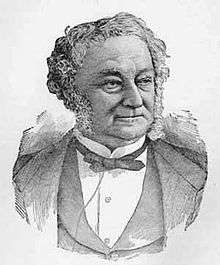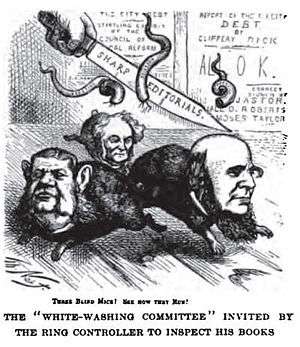Moses Taylor

Moses Taylor (January 11, 1806 – May 23, 1882) was a 19th-century New York merchant and banker and one of the wealthiest men of that century. At his death, his estate was reported to be worth $70 million, or about $1.7 billion in today's dollars. He controlled the National City Bank of New York (later to become Citibank), the Delaware, Lackawanna & Western railroad, the Moses Taylor & Co. import business, and he held numerous other investments in railroads and industry.
Early life and career
His parents were Jacob B. Taylor and Martha (Brant) Taylor. His father was a close associate of John Jacob Astor and acted as his agent by purchasing New York real estate while concealing Astor's interest. Astor's relationship with the Taylor family provided Moses with an early advantage.
Moses began his career at age 15 at J. D. Brown shippers, but soon moved to a clerk's position in the firm of G. G. & S. Howland Company of New York, a shipping and import firm that traded with South America. By 1832, at age 26, Moses had sufficient wealth to marry, leave the Howland company, and start his own business as a sugar broker. As a sugar broker, Moses dealt with Cuban sugar growers, found buyers for their product, exchanged currency, and advised and assisted them with their investments. Although he never visited Cuba, Taylor's friendship with Henry Augustus Coit, a prominent trader who was fluent in Spanish, allowed him to trade with the Cuban growers. Taylor soon discovered that loans and investments provided returns that were as good as, or better than, those from the sugar business. By the 1840s his income was largely from interest and investments. By 1847, Moses Taylor was listed as one of New York City's 25 millionaires.
Banking and Investments
When the Panic of 1837 allowed Astor to take over what was then City Bank of New York (Citibank), he named Moses Taylor as director. Moses himself had doubled his fortune during the panic, and brought his growing financial connections to the bank. He acquired equity in the bank and in 1855 became its president, operating it largely in support of his and his associates' businesses and investments.
In the 1850s Moses invested in iron and coal, and began purchasing interest in the Delaware, Lackawanna & Western railroad. When the Panic of 1857 brought the railroad to the brink of bankruptcy, Moses obtained control by purchasing its outstanding shares for $5 a share. Within seven years the shares became worth $240, and the D. L. & W was one of the premier railroads of the country. By 1865 Moses held 20,000 shares worth almost $50 million.

Moses held an interest in the New York, Newfoundland, and London Telegraph Company that Cyrus West Field had founded in 1854. Although its attempts to lay a cable across the Atlantic were initially unsuccessful, it eventually succeeded and in 1866 became the first transatlantic telegraph company.
Taylor also had controlling interest in the largest two of the seven gas companies in Manhattan that were merged (after his death) to form the Consolidated Gas Company in 1884, eventually becoming Consolidated Edison. Taylor's Manhattan Gas Company and New York Gas Light Company were 45% of the merged Consolidated Gas.
Tammany Hall
After the Civil War, during which he assisted the Union with financing the war debt, he continued to invest in iron, railroads, and real estate. His real estate holdings in New York brought him into close association with Boss Tweed of New York's Tammany Hall. Moses sat on a committee in 1871, made up of New York's most influential and successful businessmen and signed his name to a report that commended Tweed's controller for his honesty and integrity. This report was considered a notorious whitewash.
Legacy
Not noted for philanthropy during his life, at the end in 1882 Moses Taylor donated $250,000 to build a hospital in Scranton, Pennsylvania to benefit his iron and coal workers, and workers of the D. L. & W railroad. The Moses Taylor hospital continues in operation today.
Moses died in 1882 and although he owned a vault at the New York City Marble Cemetery which already contained members of his family, he was buried in Green-Wood Cemetery in Brooklyn, New York.
Descendants
Moses left his fortune to his wife and children: his son Henry Augustus Coit Taylor, his daughter Albertina Shelton Taylor Pyne, his daughter Katherine Wilson Taylor Winthrop, his daughter Mary Taylor Lewis, and his son George Campbell Taylor. Several prominent wealthy families owe a substantial portion of their fortunes to those inheritances.
Percy Rivington Pyne (1820–1895), an assistant to Moses, had married Moses' daughter Albertina in 1855 and became president of City Bank upon his father-in-law's death. The Pynes established a dynasty of bankers that survives to this day. Percy's son Moses Taylor Pyne was a benefactor of Princeton University who supported its development from a college into a university and left an estate worth $100 million at his death in 1921.
The Winthrop family descendants of John Winthrop inherited the wealth of Moses's daughter Katherine Wilson Taylor (1839–1925) who married Robert Winthrop (1833–1892). Katherine's daughter married Hamilton Fish Kean (1862–1941), ancestor of the political Kean family which includes the former governor of New Jersey Thomas Kean.
Moses' son Henry A. C. Taylor left an estate worth $50 million upon his death in 1921, just a few months before the death of his nephew Moses Taylor Pyne.
The Taylor family descendants of Moses's son Henry Augustus Coit Taylor were prominent New York and Newport socialites.
References
- "The Business Career of Moses Taylor" by Daniel Hodas, New York: New York University Press (1976).
- Capital City : New York City and the Men Behind America's Rise to Economic Dominance, 1860–1900, Thomas Kessner
- "An Old Merchant's Death", obituary of Moses Taylor in the New York Times, May 24, 1882.
- "An Old Merchant's Death", Alan Singer, Graduate Director: Social Studies Education, Hofstra University
- Dynastic America and Those Who Own It, 1921 by Henry H Klein, p. 30
- Banking Alliances, by Hazel J. Johnson, World Scientific, 2000, p 47
- Thomas Nast: His Period and His Pictures, Albert Bigelow Paine, Macmillan, 1904, p. 144
External links
| Wikimedia Commons has media related to Moses Taylor. |
| Business positions | ||
|---|---|---|
| Preceded by Gorham A. Worth |
President of National City Bank 1855–1882 |
Succeeded by Percy Pyne |